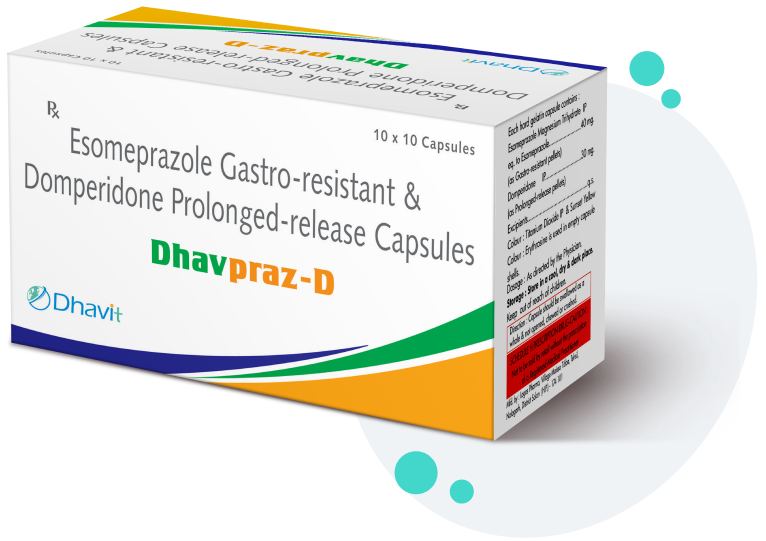
Dhavpraz-D Capsules
Composition
Each capsule contains:
| Esomeprazole Magnesium: | 40 mg (as enteric-coated pellets) |
| Domperidone: | 30 mg (as sustained-release pellets) |
Description
Esomeprazole belongs to a class of antisecretory compounds (substituted benzimidazole proton-pump inhibitors (PPI’s) that do not exhibit anticholinergic or histamine H2-receptor antagonist properties, but suppress gastric acid secretion by inhibiting the gastric H+/K+ ATPase at the secretory surface of the gastric parietal cell. Because this enzyme is regarded as the acid (proton) pump within the parietal cell, esomeprazole has been characterized as a gastric PPI. Esomeprazole blocks the final step of gastric acid secretion. In gastric parietal cells, esomeprazole is protonated, accumulates, and is transformed to an active sulfenamide.
Domperidone is a derivative of benzimidazole that possesses both pro-kinetic and anti-emetic properties due to its inhibitory action at dopamine D2-receptors.
Pharmacodynamics
Esomeprazole
Mechanism of Action
Esomeprazole is a proton-pump inhibitor (PPI) that suppresses gastric acid secretion by specific inhibition of the H+/K+-ATPase in the gastric parietal cell. The S- and R-isomers of omeprazole are protonated and converted in the acidic compartment of the parietal cell forming the active inhibitor, the achiral sulfenamide. By acting specifically on the proton pump, esomeprazole blocks the final step in acid production, thus reducing gastric acidity. This effect is dose-related up to a daily dose of 20 to 40 mg and leads to inhibition of gastric acid secretion./p>
Domperidone
Domperidone is a dopamine antagonist with anti-emetic properties. Domperidone does not readily cross the blood-brain barrier. In domperidone users, especially in adults, extra-pyramidal side effects are very rare, but domperidone promotes the release of prolactin from the pituitary. Its anti-emetic effect may be due to a combination of peripheral (gastrokinetic) effects and antagonism of central dopamine receptors in the chemoreceptor trigger zone, which lies outside the blood-brain barrier in the area postrema. Animal studies, together with the low concentrations found in the brain, indicate a predominantly peripheral effect of domperidone on dopamine receptors. Studies in humans have shown oral domperidone to increase lower oesophageal pressure, improve intraduodenal motility and accelerate gastric emptying. There is no effect on gastric secretion.
Pharmacokinetics
Esomeprazole
Absorption
The AUC after administration of a single 40 mg dose of esomeprazole is decreased by 43% to 53% after food intake, compared to fasting conditions. Esomeprazole should be taken at least 1 hour before meals.
Distribution
Esomeprazole is 97% bound to plasma proteins. Plasma protein binding is constant over the concentration range of 2 to 20 µmol/L. The apparent volume of distribution at the steady state in healthy volunteers is approximately 16 L.
Metabolism
Esomeprazole is extensively metabolized in the liver by the cytochrome (CY) P450 enzyme system. The metabolites of esomeprazole lack anti-secretory activity.
Excretion
The plasma elimination half-life of esomeprazole is approximately 1 to 1.5 hours. Less than 1% of parent drug is excreted in the urine. Approximately 80% of an oral dose of esomeprazole is excreted as inactive metabolites in the urine, and the remainder is found as inactive metabolites in the faeces.
Domperidone
Absorption
In fasting subjects, domperidone is rapidly absorbed after oral administration, with peak plasma concentrations at 30 to 60 minutes.
Distribution
Oral domperidone does not appear to accumulate or induce its own metabolism; a peak plasma level after 90 minutes of 21ng/ml after 2 weeks of oral administration of 30 mg per day was almost the same as that of 18 ng/ml after the first dose. Domperidone is 91% to 93% bound to plasma proteins.
Metabolism
Domperidone undergoes rapid and extensive hepatic metabolism by hydroxylation and N-dealkylation.
Excretion
Urinary and faecal excretions amount to 31% and 66% of the oral dose, respectively. The proportion of the drug excreted unchanged is small (10% of faecal excretion and approximately 1% of urinary excretion). The plasma half-life after a single oral dose is 7 to 9 hours in healthy subjects, but is prolonged in patients with severe renal impairment.
Indications
Dhavipraz-D Capsules – GERD (gastroesophageal reflux disease) not responding to esomeprazole alone.
Dosage and Administration
Dhavipraz-D Capsules – One Capsule, once daily
Contraindications
Dhavipraz-D are contraindicated in patients with a known hypersensitivity to esomeprazole, domperidone or to substituted benzimidazoles or to any excipients used in the formulation.
It is also contraindicated in patients with a prolactin-releasing pituitary tumour (prolactinoma), hepatic and renal impairment.
Storage and Handling Instructions
Store in a cool and dry place. Protect from light.
Packaging Information
Dhavipraz-D Capsules – Strip pack of 10 capsules
Got a question?
We’d love to talk about how we can help you.